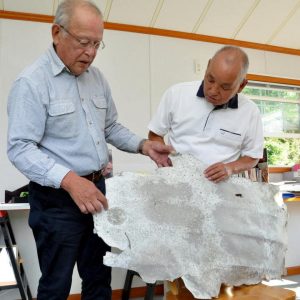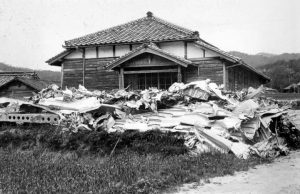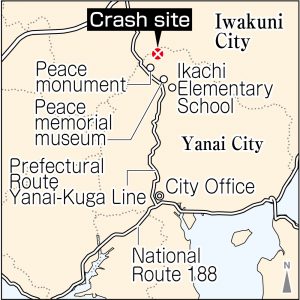Debris from U.S. military plane that crashed in Yanai at end of war and kept by resident recently donated to local museum
Jul. 25, 2024
Plane’s crew members killed in atomic bombing as POWs
by Yuji Yamamoto, Staff Writer
Around the end of the Pacific theater of World War II, a U.S. military B-24 bomber crashed in the Ikachi area of Yanai City in Yamaguchi Prefecture, with many of the plane’s crew captured, taken to Hiroshima, and later killed in the atomic bombing. A resident of Ikachi had for a long time held onto a piece of metal debris believed to have been part of the bomber. In hopes it could be utilized more effectively, the resident has donated the debris to a local peace memorial museum.
The debris is made up of sheet metal measuring 63 centimeters in length, 106 centimeters in width, and less than one millimeter in thickness. On the metal surface, marks of rivetted seams remain. Attached to the top and bottom of the backside are reinforcing materials measuring six centimeters in height. Wording is partially visible but not readable. Thought to made of the alloy duralumin, the debris contains marks from bullets that have the appearance of being pounded out and repaired with a round metal plate.
Chiyuki Kawamura, 79, a resident of the local area, had held onto the debris at his home. In 1980, when he moved to his current residence after marrying into his wife’s family, his mother-in-law told him that his wife’s grandfather had collected the debris at the site where the U.S. military plane had crashed. After the U.S. bomber first crashed, residents of the area retrieved some of the debris from the plane and formed the materials into dustpans and other objects. Because no one in Mr. Kawamura’s family had metalworking skills, the part was left untouched.
Mr. Kawamura made the decision to donate the metal debris after being inspired last year by a documentary film he saw locally about the story of tracking down the surviving families of the U.S. soldiers on the crashed military airplane. After the film, he thought the airplane debris should be displayed at the local peace memorial museum that had organized the screening of the film and was working to convey information about the history of the U.S. military plane crash and the A-bombed American soldiers. He consulted with Masanori Takenaga, 73, manager of the museum, who agreed to archive the debris at the museum.
Yozo Kudo, 74, is a former professor at Tokuyama College of the National Institute of Technology who has been researching the damage from air raids in Japan and serving as chair of a group that works to record data on air strikes and war devastation. Mr. Kudo, who now lives in Shunan City, Yamaguchi Prefecture, explained that, after the war, the debris from the U.S. military plane that crashed in the Ikachi area had been collected and placed in front of a public hall near the crash site and then taken to Osaka, based on an order from the U.S. military. With that, no large fragments of the plane remained in the local area. After looking at a photo of the metal debris, Mr. Kudo said, “If the story of retrieving the material from the crash site is true, the metal debris would be a fragment from the U.S. bomber. Such a huge part is unusual.”
Mr. Kawamura expressed his wishes for the object. “This is an artifact of a war in which Japan and the United States fought each other at that time. It’s emotional for me, and I hope everyone can have a chance to look at it.” Mr. Takenaga said, “It is important material as evidence that a U.S. military aircraft crashed in the area. It will lend realism for people learning about the story of U.S. soldiers dying in the atomic bombing after the crash. I hope to take good care of it.”
On July 28, a date marking 79 years since the crash of the U.S. bomber, Mr. Takenaga plans to reveal the metal debris to the public as part of a peace event held at the Midorigaoka Library in Yanai City, starting at 2 p.m.
Keywords
U.S. military plane crashed in Ikachi, Yanai City
On July 28, 1945, the U.S. military B-24 bomber “Lonesome Lady” left Yomitan Airfield in Okinawa Prefecture, attacked the battleship Haruna, stationed off the coast of Kure, and crashed at what was then known as Ikachi Village in Yamaguchi Prefecture after it took heavy anti-aircraft fire. Six of the nine crew members onboard were detained at the Chugoku Military Police Headquarters in Hiroshima, becoming prisoners of war, and were later killed in the atomic bombing by the U.S. military on August 6. In 1998, residents of the Ikachi area built a peace monument to mourn the lost soldiers’ lives next to a public hall located near the crash site.
(Originally published on July 25, 2024)










